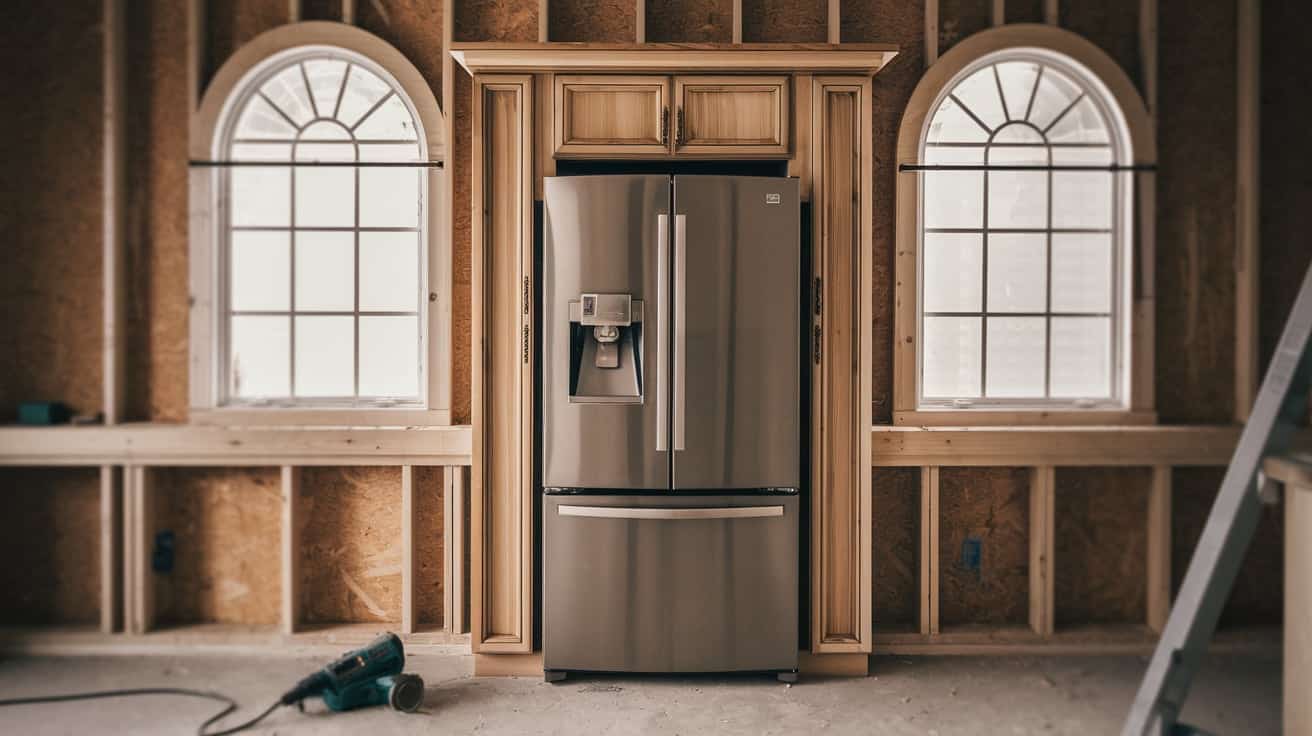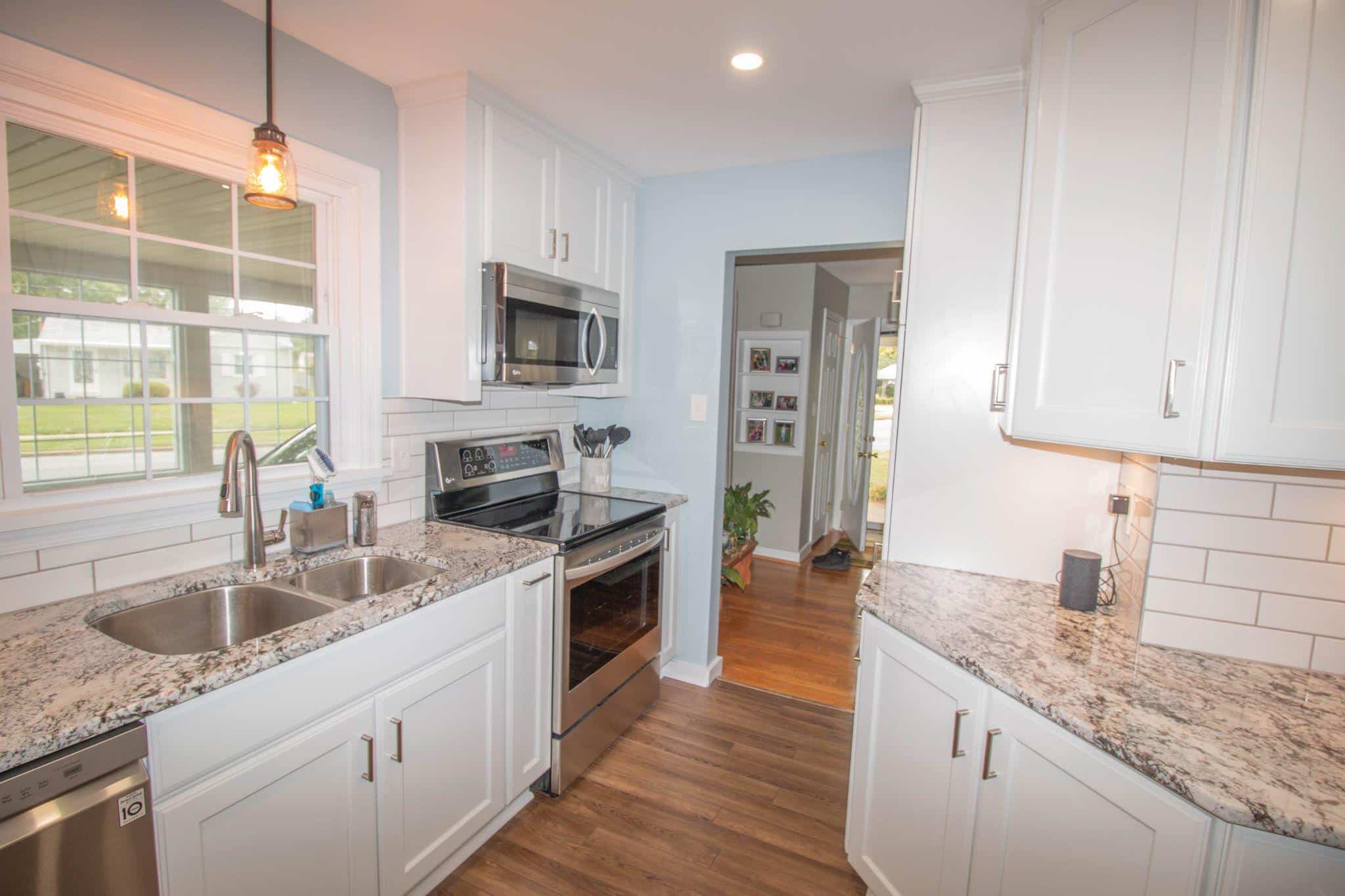The space above the fridge often becomes a messy catch-all spot that wastes potential storage space.
I know the feeling; my kitchen struggled with this common problem, and the stock cabinets didn’t fit my fridge’s dimensions.
Building a custom cabinet completely changed my kitchen storage game. With basic tools and materials, I created the perfect cabinet for my space and needs.
This method helps you avoid the high costs of custom orders while getting better-quality storage that matches your existing cabinets.
In this guide, I’ll share my step-by-step process for building an over-fridge cabinet, including material choices, measurements, construction tips, and finishing touches.
You’ll learn how to make a cabinet that looks like it came with your kitchen.
Required Tools for Custom Refrigerator Cabinet
| Tool | Purpose | Quantity |
|---|---|---|
| Table Saw | Cutting plywood and boards to precise dimensions | 1 |
| Dado Blade Set | Creating grooves in wood for cabinet door panels | 1 Set |
| Brad Nailer | Attaching face frames and backing securely with nails | 1 |
| Drill with Pocket Hole Jig | Drilling pocket holes for strong joinery | 1 |
| Jigsaw or Oscillating Tool | Making detailed cuts, such as around outlets or obstructions | 1 |
| Foam Roller | Applying smooth, even coats of paint | 1 |
| Clamps | Holding pieces firmly while the glue dries and fasteners are installed | As needed |
| Concealed Hinge Jig | Ensuring accurate hinge placement for cabinet doors | 1 |
| Measuring Tools | Ensuring precise measurements for accurate cuts and assembly | 1 Set |
Required Materials for Custom Refrigerator Cabinet
| Material | Purpose | Quantity |
|---|---|---|
| 1/2 inch birch plywood | Main cabinet box construction | As needed |
| 1/2 inch maple plywood | Optional alternative for cabinet panels | As needed |
| 1/4 inch plywood for backing | Backing for added stability | As needed |
| 1×3 pine boards for face frames | Building face frames for a finished look | As needed |
| Wood glue | Securing wood joints | 1 bottle |
| Brad’s nails | Fastening face frames and backing | As needed |
| Pocket hole screws | Strong joinery for structural integrity | As needed |
| Edge banding | Covering exposed plywood edges | As needed |
| 2x4s for base | Creating a base for proper cabinet height | As needed |
| Oil-based primer | Providing a smooth, durable base for paint | 1 can |
| Cabinet paint | Final cabinet color and protection | 1 can |
| Wood filler | Filling gaps and nail holes | 1 container |
| Caulk | Sealing joints and edges for a clean finish | 1 tube |
Step-By-Step Guide on How to Build a Refrigerator Cabinet
Step1- Preparing Your Plywood
Cut your 1/2-inch plywood sheets for your cabinet boxes. Include sides, top, bottom, and middle shelf. Take careful measurements of your fridge space.
Step 2- Building the Cabinet Box Frame
Make pocket holes on the top and bottom pieces. Join these to side pieces using wood glue and pocket hole screws. Keep everything aligned as you work.
Step 3- Adding the Support Structure
Place three-inch-wide support boards (cut from leftover plywood) along the back edges. These will help attach the cabinet to the wall studs later.
Line them up with cabinet edges. Place three-inch-wide boards with the
Step 4- Installing the Middle Shelf
Set a shorter-depth shelf in the middle of each cabinet box. Make it less deep than the cabinet for better access to back items.
Secure with pocket holes and glue.
Step 5- Complete the Box Construction
Cover exposed plywood edges with iron-on edge banding. Add 1/4-inch plywood backing, secured with brad nails for stability.
Step 6- Constructing the Base Support
Make a base from 2x4s to set the cabinet at the needed height. This will help match your existing cabinets. Check the level before proceeding.
Step 7- Attaching the Face Frames
Create frames from 1×3 pine boards. Leave 1/8-inch extra on all sides except the bottom middle section and 1-1/2 inches for fridge space. Attach with glue and brad nails.
Step 8- Crafting the Cabinet Doors
Cut door pieces from 1×3 pine. Use a dado blade to create grooves for panels. Build the frame, insert 1/4-inch plywood panels, and hold them with clamps until dry. Fill gaps with wood filler.
Step 9- Installing the Hardware
Make holes for door hardware using a hinge jig. Install the hinges and test the doors before the final attachment.
Make any needed changes to ensure a good fit
Step 10- Applying the Final Finish
Fill nail holes and seams with wood filler. Sand and prime all surfaces. Use a foam roller to apply two coats of paint, letting each coat dry fully.
Video Tutorial
Check out this YouTube video for a detailed step-by-step tutorial on making a refrigerator cabinet.
Tips and Tricks
1. With current supply issues, verify material availability before starting your project.
2. Ensure pocket holes are placed on the correct sides before assembly to avoid rework.
3. For utility cabinets, including power outlet access for charging items like vacuums.
4. Add extra support boards where cabinets join together for better stability.
5. Build separate bases to achieve perfect height when standard cabinet sizes don’t work.
6. Test Cuts First, Use scrap material to test dado blade settings before cutting door components.
7. Use foam rollers for smooth paint application when spray equipment isn’t available.
8. Remember that measurements should be customized to your specific kitchen space rather than following exact dimensions from others.
Necessity of Maintenance
1. Proper care extends the life of your over-fridge cabinets. Regular dusting with a soft cloth prevents buildup on surfaces. Clean spills immediately with a damp cloth to prevent staining or damage to the paint finish.
2. Check hinges every six months – tighten any loose screws and apply a small amount of lubricant if doors squeak. This keeps doors working well and prevents sagging.
3. Look for signs of water damage, especially if your fridge has an ice maker or water dispenser. Watch for warping or discoloration near the base. Quick repairs prevent bigger issues later.
Common Mistakes to Avoid
1. Wrong measurements cause major problems. Always check the height of the fridge with the doors open and account for ventilation space. Leave enough room above and behind the refrigerator for proper airflow.
2. Skipping support blocks leads to sagging cabinets. Add extra bracing to wall studs, especially for heavy items. Don’t rely solely on screws into drywall.
3. Poor door alignment frustrates users. To ensure proper function, adjust the hinges properly. Also, test the doors multiple times before final installation.
4. Inadequate ventilation shortens refrigerator life. Leave recommended space around your fridge. Check manufacturer guidelines for specific requirements.
5. Missing the wall studs when mounting creates safety risks. Use a stud finder to mark the locations. If needed, add blocking between the studs for better support.
6. The final result shows that the painting process was rushed. Allow proper drying time between coats and lightly sand between layers to improve paint adhesion.
Conclusion
Creating cabinets above your refrigerator opens up valuable storage potential in your kitchen.
This guide walked you through the process, from basic box construction to adding finishing touches.
While it may seem like a big task, breaking it down into smaller steps makes it manageable for DIY enthusiasts of all skill levels.
Remember that attention to detail during measurement and planning helps prevent issues later.
The support structure deserves special attention; it is essential for long-term stability. Your choice of materials and hardware will influence both function and longevity.
By following these steps and staying mindful of common errors, you can build storage that matches your needs and your existing cabinetry.
The satisfaction of completing this project yourself makes the effort worthwhile.








